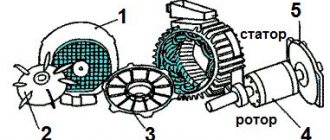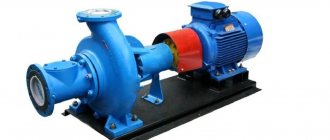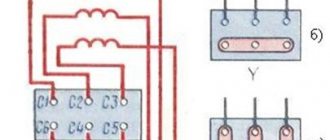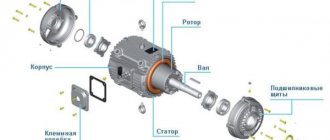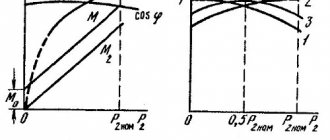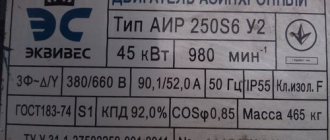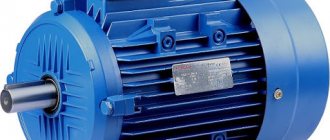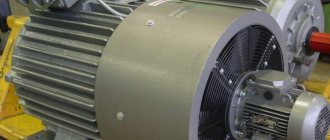In this article we will cover the topic of mechanical and electrical characteristics of electric motors. Using the example of an asynchronous motor, we will consider such parameters as power, work, efficiency, cosine phi, torque, angular speed, linear speed and frequency. All these characteristics are important when designing equipment in which electric motors serve as drives. Today, asynchronous electric motors are especially widespread in industry, so we will focus on their characteristics. For example, consider AIR80V2U3.
Rated mechanical power of an asynchronous electric motor
The nameplate (nameplate) of the electric motor always indicates the rated mechanical power on the shaft of this motor. This is not the electrical power that this electric motor consumes from the network.
So, for example, for an AIR80V2U3 engine, a rating of 2200 watts corresponds precisely to the mechanical power on the shaft. That is, in optimal operating mode, this engine is capable of performing mechanical work of 2200 joules every second. Let's denote this power as P1 = 2200 W.
Rated active electrical power of an asynchronous electric motor
To determine the rated active electrical power of an asynchronous electric motor based on nameplate data, it is necessary to take into account the efficiency. So, for this electric motor the efficiency is 83%.
What does it mean? This means that only part of the active power supplied from the network to the stator windings of the motor, and irreversibly consumed by the motor, is converted into mechanical power on the shaft. Active power is equal to P = P1/efficiency. For our example, from the presented nameplate we see that P1 = 2200, efficiency = 83%. This means P = 2200/0.83 = 2650 W.
Rated apparent electrical power of an asynchronous electric motor
The total electrical power supplied to the stator of an electric motor from the network is always greater than the mechanical power on the shaft and greater than the active power irretrievably consumed by the electric motor.
To find the total power, it is enough to divide the active power by the cosine phi. Thus, the total power is S = P/Cosφ. For our example, P = 2650 W, Cosφ = 0.87. Therefore, the total power S = 2650/0.87 = 3046 VA.
Rated reactive electric power of an asynchronous electric motor
Part of the total power supplied to the stator windings of an asynchronous electric motor is returned to the network. This is the reactive power Q.
Reactive power is related to apparent power via sinφ, and is related to active and apparent power via square root. For our example:
Q = √( 3046 2 – 2650 2 ) = 1502 VAR
Reactive power Q is measured in VAR - in reactive volt-amperes.
Now let's look at the mechanical characteristics of our asynchronous motor: rated operating torque on the shaft, angular speed, linear speed, rotor speed and its relationship with the motor supply frequency.
Rotor speed of an asynchronous electric motor
On the nameplate we see that when powered by alternating current with a frequency of 50 Hz, the motor rotor makes 2870 revolutions per minute at rated load, let’s denote this frequency as n1.
What does it mean? Since the magnetic field in the stator windings is created by an alternating current with a frequency of 50 Hz, then for a motor with one pair of poles (which is AIR80V2U3), the “rotation” frequency of the magnetic field, the synchronous frequency n, turns out to be equal to 3000 revolutions per minute, which is identical to 50 revolutions per second. But since the motor is asynchronous, the rotor rotates with a lag by the slip amount s.
The value of s can be determined by dividing the difference between the synchronous and asynchronous frequencies by the synchronous frequency, and expressing this value as a percentage:
s = ( ( n – n1 )/ n) *100%
For our example, s = ( (3000 – 2870)/3000 ) *100% = 4.3%.
Angular speed of asynchronous motor
Angular velocity ω is expressed in radians per second. To determine the angular velocity, it is enough to convert the rotor speed n1 into revolutions per second (f), and multiply by 2 Pi, since one full revolution is 2 Pi or 2 * 3.14159 radians. For the AIR80V2U3 engine, the asynchronous frequency n1 is 2870 rpm, which corresponds to 2870/60 = 47.833 rpm.
Multiplying by 2 Pi, we have: 47.833*2*3.14159 = 300.543 rad/s. You can convert it to degrees; to do this, substitute 360 degrees instead of 2 Pi, then for our example you get 360 * 47.833 = 17220 degrees per second. However, such calculations are usually carried out in radians per second. Therefore, the angular velocity is ω = 2*Pi*f, where f = n1/60.
Linear speed of an asynchronous electric motor
Linear speed v refers to equipment where an asynchronous motor is installed as a drive. So, if a pulley or, say, an emery disk of known radius R is installed on the motor shaft, then the linear speed of a point on the edge of the pulley or disk can be found by the formula:
Rated torque of asynchronous motor
Each asynchronous electric motor is characterized by a rated torque Mn. Torque M is related to mechanical power P1 through angular velocity as follows:
The torque or moment of force acting at a certain distance from the center of rotation is conserved for the engine, and as the radius increases, the force decreases, and the smaller the radius, the greater the force, because:
So, the larger the radius of the pulley, the less force acts on its edge, and the greatest force acts directly on the electric motor shaft.
For the AIR80V2U3 engine given as an example, the power P1 is equal to 2200 W, and the frequency n1 is equal to 2870 rpm or f = 47.833 rpm. Therefore, the angular velocity is 2*Pi*f, that is, 300.543 rad/s, and the nominal torque Mn is equal to P1/(2*Pi*f). Mn = 2200/(2*3.14159*47.833) = 7.32 N*m.
Thus, based on the data indicated on the nameplate of the asynchronous electric motor, you can find all its main electrical and mechanical parameters.
We hope that this article helped you understand how angular velocity, frequency, torque, active, net and apparent power, as well as the efficiency of an electric motor, are related to each other.
Source: electric.info
Motor rated power
Terms and Definitions.
The wide variety of types and designs of electrical machines and the need for an objective assessment and comparison of their data have led to the need to standardize basic concepts in the field of characteristics, design parameters and operating modes of machines. The terms and definitions of these quantities are established by several GOSTs and are mandatory for use in all types of documentation, textbooks, teaching aids, technical and reference literature. The standards contain more than 200 terms and definitions. This paragraph provides the main ones that apply to all or many types of rotating electrical machines, regardless of their purpose and design. Asynchronous electric motor An asynchronous electric motor is an electrical asynchronous machine for converting electrical energy into mechanical energy. The operating principle of an asynchronous electric motor is based on the interaction of a rotating magnetic field, which arises when a three-phase alternating current passes through the stator windings, with a current induced by the stator field in the rotor windings, resulting in mechanical forces that cause the rotor to rotate in the direction of rotation of the magnetic field. Synchronous electric motor A synchronous electric machine is an electric machine whose rotation speed n (rpm) is connected by a constant ratio with the frequency n = 60 * f / p (where p is the number of pole pairs of the machine) of the alternating current network in which this machine is connected. Synchronous machines serve as alternating current generators; synchronous electric motors are used in all cases where a motor operating at a constant speed is needed; To obtain controlled reactive current, synchronous compensators are installed. DC electric motor Although the modern power supply system is based on the use of alternating current, nevertheless, DC machines are widely used in a wide variety of industries and in everyday life.
Types of electric motors
Commutator motors
A commutator machine is a rotating electrical machine in which at least one of the windings involved in the main energy conversion process is connected to a collector [1]. In a commutator motor, the brush-commutator assembly serves as a rotor position sensor and a current switch in the windings.
Universal electric motor
DC brushed motor
- With permanent magnets
- With field winding
Brushless motors
Brushless motors may have slip rings with brushes, so there is no need to confuse brushless and brushless motors.
A brushless machine is a rotating electrical machine in which all electrical connections of the windings involved in the main energy conversion process are carried out without sliding electrical contacts [1].
Asynchronous electric motor
- Single phase
- Two-phase
- Three-phase
Synchronous electric motor
- With field winding
- With permanent magnets
- Reactive
- Hysteresis
- Reactive-hysteresis
- Stepper
What is rated power?
We come across the term “rated power” almost every day. Whether we choose an electric kettle or an incandescent lamp, this value is indicated everywhere. The unit of measurement is watts or kilowatts. It would seem - what could be simpler in this matter? After all, even from a school physics course, everyone knows that to determine power (P) it is enough to multiply the values of current and voltage. But what is hidden behind the words “rated power”? The term “nominal” refers to a certain value of something that does not take into account external corrective factors. Thus, the rated power is the value specified by the manufacturer, which can only be obtained with the specified design parameters. This is a general concept. In each specific case, it is necessary to take into account its specific features. Let's take an example with an incandescent lamp. Its glass bulb is marked: 230 V, 100 W. That is, 100 W can only be achieved at a voltage of 230 V. The rated power is those same 100 W. Its value decreases with decreasing voltage and increases with increasing voltage since these parameters are directly dependent on each other (P=I*U).
Operating modes of electric motors
The operating mode determines the load on the electric motor. In some cases it remains virtually unchanged, in others it may change. The nature of the expected load must be taken into account when choosing an engine. Current standards provide for the following operating modes:
Mode S1 (long-term). In this operating mode, the load remains constant for the entire time until the temperature of the electric motor reaches the required value. Drive power is calculated using the formulas given above.
Mode S2 (short-term). When operating in this mode, the engine temperature during its switching on does not reach the steady-state value. During shutdown, the electric motor cools down to ambient temperature. During short-term operation, it is necessary to check the overload capacity of the electric drive.
Mode S3 (periodically-short-term). The electric motor operates with periodic shutdowns. During periods of switching on and off, its temperature does not have time to reach the set value or cool down to the ambient temperature. When calculating engine power, the duration of pauses and losses during transition periods must be taken into account. When choosing an electric motor, an important parameter is the permissible number of starts per unit of time.
Modes S4 (periodically short-term, with frequent starts) and S5 (periodically short-term with electric braking). In both cases, the engine operation is considered according to the same parameters as in operating mode S3.
Mode S6 (periodically-continuous with short-term load). Operation of the electric motor in this mode involves operation under load, alternating with idling.
Mode S7 (intermittent-continuous with electric braking)
Mode S8 (periodically-continuous with simultaneous change in load and rotation speed)
Mode S9 (mode with non-periodic changes in load and rotation speed)
Most models of modern electric drives, which have been in operation for a long time, are adapted to changing load levels.
Selecting a generator by power
When choosing a generator, the consumer pays attention to various installation parameters - weight, service life, mobility, availability of additional functionality, price, etc. But first of all, you need to choose an installation based on its power. How to correctly calculate this indicator and what to pay attention to?
To make it clearer, let's look at this situation using a simple example. Let's say we have the following household appliances: a vacuum cleaner, a heater, a freezer. The power of these household appliances is 1 kW, 2 kW and 0.3 kW, respectively. It turns out that in order to ensure the operation of these devices, we need a generator with a power of at least 3 kW. To understand this, let's understand the concept of rated power of the generator.
The nominal, or, as it is also called, the real power of the installation, differs significantly from the maximum. In technical documentation, manufacturers most often indicate the maximum power ratings for a given generator model. It is worth noting that with such a load the installation can operate for a very short time without critical consequences - in some cases it is seconds, sometimes 1-2 minutes. At the same time, the real or rated power is slightly lower than the maximum. To calculate it, the power factor cos φ is required. This indicator is determined by the ratio of active power to total power.
Car engine power calculator
Power is an important technical parameter of an internal combustion engine. It affects the dynamics of acceleration, the size of the maximum speed and the elasticity of the motor. It also affects the amount of transport tax, which almost every motorist is required to pay.
To find out the strength of your engine, you will need special formulas and calculation methods. The car engine power calculator, which is presented below in our article, can also help you.
- Calculation of engine power: methods and necessary formulas
- Calculation via torque
- What is torque
- How are engine speeds calculated?
- Calculation of power by engine volume
- Air flow calculation
- Calculation of weight and acceleration time from zero to hundreds
- Calculation of injector performance
- Horsepower calculation
- What is horsepower in a car?
Calculation of engine power: methods and necessary formulas
Engine power is the energy that is generated inside the internal combustion engine during its operation. This indicator is key for any car, and many motorists rely on it when choosing a car. It can be defined in various ways. Let's list the main methods:
- Through revolutions and torque.
- By volume of internal combustion engine.
- By air flow.
- In terms of weight and acceleration time to 100 kilometers per hour.
- According to the performance of injection nozzles.
The main unit of measurement for power is watts, but it is sometimes expressed in terms of horsepower. There is a simple relationship between these units of measurement, so if necessary, horsepower can be easily converted to watts (and vice versa).
In our article, we will look at the basic formulas for determining power, and also learn how to convert horsepower to watts.
Calculation via torque
This method of counting is the main one. To measure power, you need to know two technical parameters - torque and engine speed. Therefore, the calculation is carried out in two stages.
What is torque
Torque is the force that acts on a rigid body during rotation. The higher this indicator, the more powerful the engine of your vehicle will be. The following formula is used to calculate torque:
The formula is deciphered as follows:
- KM is torque.
- O is the total engine volume, expressed in liters.
- D is the pressure in the combustion chamber, expressed in MPa.
- 0.0126 is the correction factor.
How are engine speeds calculated?
To calculate operating power, we need not only torque, but also engine speed. In simple terms, RPM is the speed at which the engine crankshaft rotates. The relationship here is also direct - the higher the rotation speed, the more powerful and productive your car will be.
To calculate power through revolutions, use the following formula:
- KM is torque (the formula for calculating it can be found in the previous paragraph).
- RO - engine speed (expressed in revolutions per second).
- 9549 is the correction factor.
Please note that this formula is suitable for calculating the maximum engine power .
Unfortunately, during operation of the internal combustion engine, part of the power is “eaten up” by certain elements of the car (transmission, transfer case, air conditioning, and so on).
Therefore, in fact, the actual engine power indicator will be 10-15% less, depending on the type of car and the nature of its operation at the moment.
Calculation of power by engine volume
The attentive reader probably noticed that the first formula can be directly substituted into the second to simplify the calculations. The power in this case can be expressed as follows:
M = (KM x OD)/9549 = (O x D x OD)/(9549 x 0.0126) = (O x D x OD)/120.3.
The decoding of this formula will be standard:
- O - engine volume.
- D is the pressure in the combustion chamber.
- OD - revolutions.
- 120.3 is the new correction factor.
Please note that the pressure in the combustion chamber (variable D) in the case of a standard gasoline engine is usually in the range from 0.8 to 0.85 MPa . In the case of a reinforced forced engine, this figure will be 0.9 MPa , in the case of a diesel engine - from 1 to 2 MPa .
Air flow calculation
If your car is equipped with an on-board computer and auxiliary sensors, then the power can also be determined by air consumption.
Example
Let's say we have a generator with a power rating of 3 kVA and cos φ equal to 0.8. In this case, the rated power of this installation will be equal to:
3 kVA x 0.8=2.4 (kW)
Now you can understand why power can be indicated in certain units of measurement, in watts (W) or Volt Amperes (VA). Some manufacturers, in order to save the consumer from the need to carry out calculations, simply indicate in the accompanying documentation both power values - nominal and maximum. There are also options when the manufacturer indicates only one of the capacities and gives the value of the power factor. Some unscrupulous companies may hide the power factor from the consumer. This is done in order to pass off the generator as a more powerful unit than it actually is.
What is the power of an internal combustion engine?
Engine power is a quantity that shows how much work a motor can do per unit time. That is, the amount of energy that the engine transmits to the transmission over a certain period of time. Measured in kilowatts (kW) or horsepower (hp).
How is the power of an internal combustion engine measured?
The basic unit of power is the watt (W). Numerically, it characterizes the work of one joule (J) performed in one second. A common off-system unit is horsepower, equal to 0.736 kW. For example: an engine power of 170 kW corresponds to 231.2 hp.
What is engine power?
Power is calculated by multiplying the torque by the shaft speed. Accordingly, there are two ways to increase it: increase the torque or shaft speed. It is not easy to increase this frequency in a piston engine: inertia forces (by the square of the revolutions), loads on the structure, and friction (tens of times) influence.
How to determine how much horsepower is in an engine?
The easiest way to find out the amount of horsepower in your car's engine is to look at the car's technical data sheet. If the technical passport is missing, then you can refer to the catalog of the corresponding automaker, which indicates the capacities of all the cars it produces.
What is the rated power of the motor?
3.18 continuous power (rated power): The power that the engine can develop without time limitation during the period between maintenance specified by the manufacturer, at a given speed and environmental conditions, subject to the maintenance rules established by the manufacturer.
How is current power measured?
Electrical power is a physical quantity that characterizes the speed of transmission or conversion of electrical energy. The unit of measurement in the International System of Units (SI) is the watt (Russian designation: W, international: W).
How is S measured in electrical engineering?
Active power: symbol P, unit: Watt Reactive power: symbol Q, unit: VAR (Volt Ampere reactive) Apparent power: symbol S, unit: VA (Volt Ampere)
Taking into account the type of load
Household electrical appliances are characterized by two types of load:
The active (ohmic) load is consumed by devices that convert the received energy into heat. This is an electric stove, iron, hair dryer, air heaters, etc. The reactive load is consumed by other electrical appliances, which convert only a small portion of the energy into heat. The bulk of the energy consumed is used for another purpose. Examples of such appliances include a refrigerator, vacuum cleaner, TV, computer, etc.
If you need help choosing the generator power for your home, industrial workshop or any other facility, contact our specialists for qualified advice.
Source: www.tecnuvo.ru
BELARUS-80.1/82.1
The tractor is designed to perform various agricultural work with mounted, semi-mounted and trailed machines and implements, and transport work. Environmental standard Stage II. Tractor BELARUS-80.1 - front axle. The BELARUS-82.1 tractor is a portal-type front drive axle with bevel gearboxes.
| Engine | D-243S2 |
| Power, kW (hp) | 60 (81) |
| Wheel formula | 4x2/4x4 |
- home
- Products
- Tractors
- Basic model BELARUS-80.1
- Specifications
| Engine | |
| Type | Diesel with direct fuel injection |
| Model | D-243S2 (MMZ) |
| Engine power, kW (hp) | 60 (81) |
| Rated rotation speed, rpm | 2200 |
| Number of cylinders, pcs. | 4 |
| Working volume, l | 4,75 |
| Maximum torque, N•m | 298 |
| Specific fuel consumption at rated power, g/kW•h | 244 |
| Torque reserve factor, % | 15 |
| Fuel tank capacity, l | 130 |
| Transmission | |
| Clutch | dry, single disc |
| Transmission | mechanical, stepped |
| Number of gears: forward/reverse | 18/4 |
| Movement speed: forward/backward | 1,9-34,3/4,09-9,22 |
| Rear PTO: | |
| independent I, rpm | 540 |
| independent II, rpm | 1000 |
| synchronous, rpm path | 3,4 |
| Hydraulic suspension system | |
| Universal, separate-unit with height adjustment, on request - with power and positional adjustment of tillage depth. | |
| Load capacity of the rear hitch on the suspension axis, kg | 3200 |
| Maximum pressure, MPa | 20 |
| Pump capacity, l/min. | 45 |
| Hydraulic system capacity, l | 25 |
| Dimensions and weight | |
| Overall length, mm | 4120 |
| Width (at the ends of the rear wheel axle shafts), mm | 1970 |
| Cabin height, mm | 2780/2800 |
| Tractor base, mm | 2370/2450 |
| Track, mm: | |
| on the front wheels | 1350-1850/1430-1990 |
| on the rear wheels | 1500-2100 |
| Agrotechnical clearance, mm | 645 |
| Smallest turning radius, m | 3,8/4,1 |
| Fording depth, m | 0,85 |
| Operating weight, kg | 3770/4000 |
| Tires: | |
| front wheels | 9,0-20/11,2-20 |
| rear wheels | 15.5R38 |
| Wheel formula | 4x2/4x4 |
- Engine Stage 0 (D-243);
- Engine Stage I (D-243S);
- Reverse gear;
- Ballast weights for rear wheels;
- Front ballast weights;
- Metal-ceramic clutch linings;
- Speed reducer;
- Power regulator ZNU;
- Combined towbar (hydraulic hook, drawbar, pendulum);
- Rear wheel doubling kit;
- Additional seat;
- Awning frame, awning base;
- Air conditioner;
- FDA with planetary helical gearboxes.
Aggregation
The three-furrow mounted plow PKMP-3-40R is designed for processing.
Three-furrow mounted plow PLN-3-35P (hereinafter referred to as the plow).
motor rated power
3.13 motor rated power
: Net mechanical power at the shaft, expressed in watts (W) or kilowatts (kW).
See also related terms:
Rated power of the electric motor(s)
Rated power of the electric motor(s)
Dictionary-reference book of terms of normative and technical documentation. academic.ru. 2015.
See what “rated motor power” is in other dictionaries:
Rated power of the electric motor (motors) - 1.7 According to GOST 10512 78 Source... Dictionary of terms of normative and technical documentation
Rated power - 4a. Rated current of the lighting device Current indicated by the manufacturer on the lighting device Source: GOST 16703 79: Lighting devices and complexes. Terms and definitions original document... Dictionary-reference book of terms of normative and technical documentation
Electrical power - Electrical power is a physical quantity that characterizes the speed of transmission or conversion of electrical energy. Contents 1 Instantaneous electrical power ... Wikipedia
STO 70238424.29.160.30.002-2009: Electric motors. Organization of operation and maintenance. Standards and requirements - Terminology STO 70238424.29.160.30.002 2009: Electric motors. Organization of operation and maintenance. Standards and requirements: 3.1 asynchronous start of a rotating AC motor: Starting a rotating electric motor... ... Dictionary of terms of normative and technical documentation
1: — Terminology 1: : dw Number of the day of the week. “1” corresponds to Monday Definitions of the term from various documents: dw DUT The difference between Moscow and UTC time, expressed by an integer number of hours Definitions of the term from... ... Dictionary-reference book of terms of normative and technical documentation
Electric motor label
Having examined any electric motor, with rare exceptions, you can find a plate screwed onto bolts, screws or rivets. What is written on this piece of metal? Let's take a nameplate, replacing the serial number on it with the name of the site.
By the way, it rarely happens that a plate for electrical equipment is in such almost perfect condition. Often the data is faded or covered with paint, because the task is for the maintenance personnel to paint the engine, and not to paint the engine, leaving the plate untouched. But we were lucky. Let's go in order.
First line
- number of phases and type of current (3
), serial number, network frequency, design and installation form, insulation class
Second line
— type of electric motor, cosine phi, possible connection diagrams, rated speed
Third line
- possible rated voltages, rated power, IP - degree of protection of the electric motor, weight, operating mode of the electric motor (S1).
Fourth line
- rated currents depending on the winding connection circuit, then which guest the ed corresponds to.
Let's look at the individual parameters in more detail.
Electric motor power: total, active and shaft
Formula for calculating the power of a three-phase asynchronous motor:
S1 - total power consumed by the motor from the network
P1 - active power consumed by the electric motor from the network (indicated on the nameplate)
P is the active power on the EM shaft.
cosf - cosine phi, power factor - phase angle between active (P) and total power (S).
In the formulas above, the power value is obtained in W, the total power value in VA. To convert to kilowatts, you need to divide the resulting value by a thousand. The value of current and voltage, respectively, in the formula above is in amperes and volts.
I1 and U1 are linear values of current and voltage, they are also called phase-to-phase. Not to be confused with phase ones. Linear ones are AB, BC, SA (380); phase - AO, VO, SO (220). If we express the power formulas in terms of the phase values of current and voltage, then instead of the root of three there will initially be a coefficient of 3. This coefficient is determined visually through the vector diagram of the three-phase voltage.
For DC motors, the formula will simply be the voltage at the motor terminals multiplied by the current drawn by the motor from the network.
Power consumption p1 is greater than the power on the EM shaft due to losses that arise when converting electrical energy into mechanical energy.
Star/Delta and 220/380, 380/660
See all the values in order as they go through the fraction. That is, it is written on the nameplate Y/D (triangle/star), which means that the currents and voltages will accordingly be first for Y, and after the fraction for the star. The only caveat is that at 220/380 the triangle will be 220, and at 380/660 the triangle will be 380. That is, to say that 380 is always a star is incorrect.
Types of electric motors
The most common is the three-phase asynchronous electric motor. DC and synchronous electric motors are rarely used.
Most electrified machines require a drive with a power of 0.1 to 10 kW, a much smaller part requires a drive with a power of several tens of kW. As a rule, squirrel-cage three-phase electric motors are used to drive working machines. Compared to a phase motor, such an electric motor has a simpler design, lower cost, greater operational reliability and ease of maintenance, slightly higher performance indicators (power factor and efficiency), and requires simple equipment for automatic control. The disadvantage of squirrel-cage electric motors is the relatively high starting current. When the power of the transformer substation and the electric motor are commensurate, its start-up is accompanied by a noticeable decrease in the network voltage, which complicates both the start-up of the motor itself and the operation of neighboring pantographs.
Along with three-phase asynchronous squirrel-cage electric motors of the basic design, separate modifications of these motors are also used: with increased slip, multi-speed, with a wound rotor, with a massive rotor, etc. Electric motors with a wound rotor are also used in cases where the power of the supply network is insufficient for starting motor with a squirrel-cage rotor.
The mechanical characteristics of asynchronous electric motors with a squirrel-cage rotor largely depend on the shape and size of the rotor slots, as well as on the method of making the rotor winding. According to these signs
Rice. 1. Torque curves M = f(S) of asynchronous electric motors
There are electric motors with a normal rotor (normal squirrel cage), with a deep groove and with two cages on the rotor. The rotor design of general-purpose squirrel-cage asynchronous electric motors with a power of over 500 W predetermines the phenomenon of current displacement in the winding, which is equivalent to an increase in its active resistance. Therefore, and also due to the saturation of the magnetic paths of dissipation fluxes, such electric motors (primarily the rotor windings) have variable parameters and the analytical expressions of their mechanical characteristics become more complicated. An increase in the active resistance of the rotor during the starting period causes an increase in the initial starting torque with a slight decrease in the strength of the initial starting current (Fig. 1).
Basic parameters of the electric motor
- Motor power
- Rated speed
- Efficiency
- Motor torque
- Rotor moment of inertia
- Rated voltage
- Electrical time constant
Motor power
Motor power is the useful mechanical power at the motor shaft.
Mechanical power
Power is a physical quantity that shows how much work a mechanism does per unit of time.
- where P
– power,
W
, - A
– work,
J
, - t
—time,
s
Work is a scalar physical quantity equal to the product of the projection of force and direction F
and the path
s
traversed by the point of application of the force.
- where s
– distance,
m
For rotational movement
- where θ – angle, rad
- where ω – angular frequency, rad/s
,
In this way, you can calculate the value of mechanical power on the shaft of a rotating electric motor
Rotation frequency
- where n
is the rotation speed of the electric motor,
rpm
Rotor moment of inertia
The moment of inertia is a scalar physical quantity, which is a measure of the inertia of a body in rotational motion around an axis, equal to the sum of the products of the masses of material points by the squares of their distances from the axis
What is the difference between power rating and power consumption?
It must be taken into account that the rated power of an electric motor is always less than the power consumption and differs by an amount determined by the characteristics of the motor (motor efficiency). The power consumption of a pump motor is the electrical power consumed from the power source.
How is power different from power consumption?
Unlike the first term, power consumption is a parameter measuring the electricity consumed by an air conditioner over a certain period of time and is measured in watts. Cooling power, in turn, is measured in BTUs, but can also be specified in Watts.
Why is the rated power different from the actual power?
In a nutshell: actual power is the power we get in practice, and rated power is the power we can calculate.
How does rated power differ from maximum power?
Rated power is the current value that is output during normal operation in normal mode. It is this indicator that is decisive when choosing an installation. The maximum value is the current that the generator can produce only for a very short time.
What is the rated power of an electrical device?
The rated (installed) power of an electrical receiver is the power for which it is designed for long-term consumption of electricity from the network at rated voltage and continuous rated operating mode. It is indicated on the nameplate or in the passport of the electrical receiver.
What types of air conditioners are there by power?
Types of air conditioners by power
| The lineup | BTU | kW |
| 7 | 7000 BTU | 2.1 kW |
| 9 | 9000 BTU | 2.6 kW |
| 12 | 12000 BTU | 3.5 kW |
| 18 | 18000 BTU | 5.3 kW |
What does Power in cooling mode mean?
Cooling power is the amount of heat that the air conditioner is capable of taking from the room where it is installed and transferring it to the condenser of the outdoor unit for cooling. Power consumed by the air conditioner.
What is the rated power of lamps?
The rated power of an incandescent lamp of a given type, Pl.nom, is understood as the calculated electrical power that is released in an incandescent lamp of a given type when it is turned on at the rated (or rated) voltage. ... In relation to each incandescent lamp, we can talk about the lower permissible limit of the luminous flux.
What is the Watt rating?
Rated power - power at the middle position of the amplifier volume control, at which other parameters of the device correspond to those stated in the technical description.
What is the rated power of an electric motor?
The engine nameplate indicates the rated net (output mechanical) power. This is the power that the engine can deliver to a mechanical load with the stated parameters without overheating. In the formulas, the rated mechanical power is denoted by P2.
What is the rated power of the generator?
RATED OR MAXIMUM GENERATOR POWER
Rated is the real (operating) power of the generator. Within the limits of the rated power, the electric generator can operate for quite a long time, or rather, until the fuel in the tank runs out.
How to understand Rated Power?
This is the engine power with which it could operate in nominal mode - the mode of efficient operation for a long time (at least several hours). Rated power is measured in watts (kW) or horsepower (hp)
What is the rated power of an electric meat grinder?
What is rated and peak power
Its productivity and energy consumption depend on the power of the meat grinder. Power can be rated or peak. Rated power is the one with which the device can operate for a long time without overheating. Household meat grinders are produced with a rated power from 130 to 1000 W.
What is the difference between active and reactive power?
We can assume that the power in an alternating current circuit is expressed by a complex number such that the active power is its real part, the reactive power is the imaginary part, the apparent power is the module, and the angle φ (phase shift) is the argument.
What is the power of electrical appliances?
Power is equal to the product of current and voltage, that is, 1 W = 1 A x 1 V. Formula: P = I x V. For example, if the current is 3 A and the voltage is 110 V, then the power is: 3 x 110 = 330 W. ... Also, the current and voltage values are indicated on the body of the electrical device or in the documentation for it.
